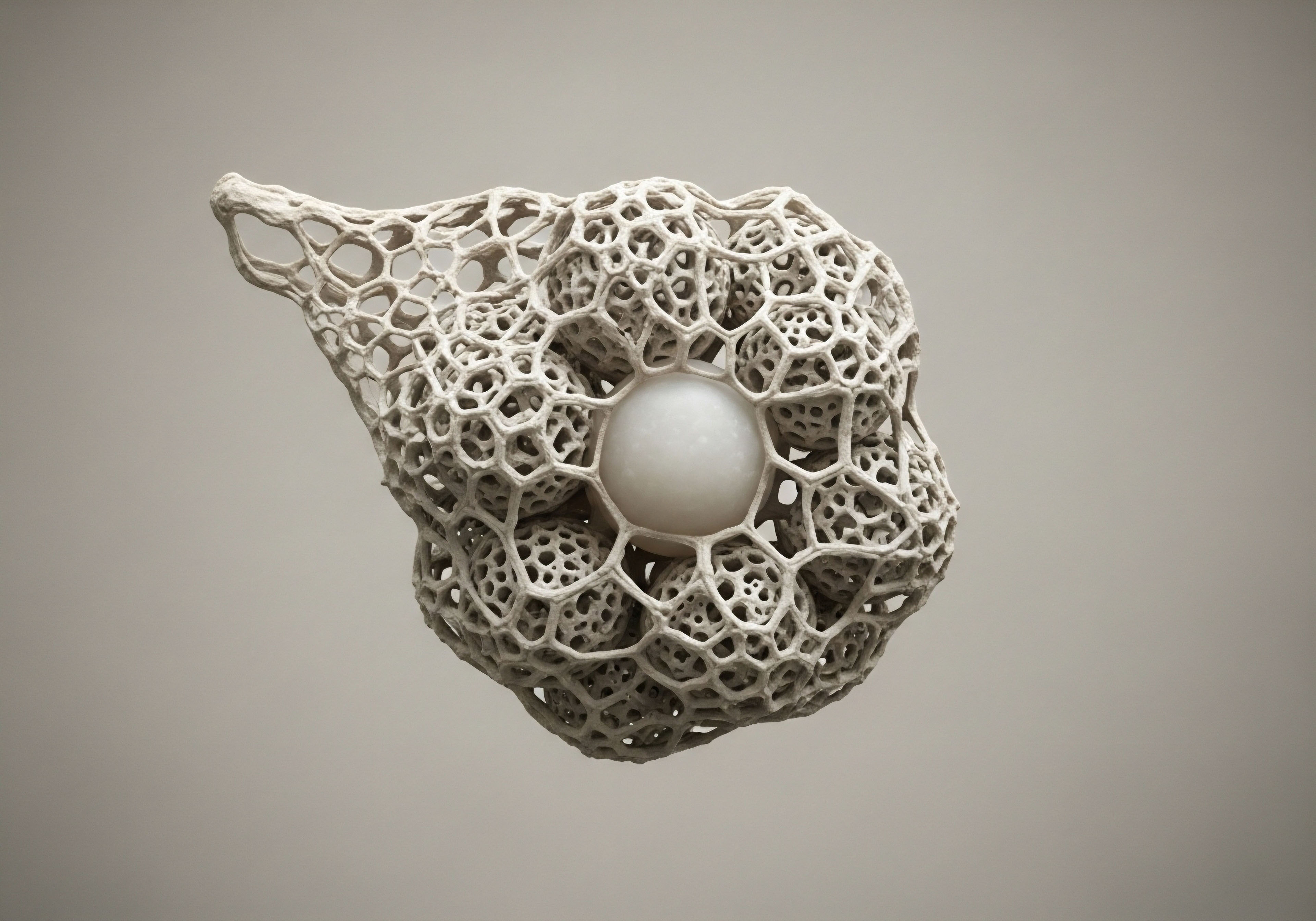

Fundamentals
You feel it in your bones. An exhaustion that coffee doesn’t touch, a subtle drag on your vitality, a sense that your internal engine is running at a lower RPM than it used to. This experience, this lived reality of diminished energy and drive, is a valid and important signal from your body.
The answer to reclaiming that function often begins the moment your head hits the pillow. The process of sleeping is an active, profoundly important period of biological reconstruction. It is the time when your body and brain perform the critical maintenance required for you to function, feel, and thrive. The quality of this nightly restoration is directly linked to the production of key hormones, including testosterone, the very molecule that underpins much of masculine vitality, muscle health, and cognitive sharpness.

The Nightly Blueprint of Hormonal Health
Think of your sleep as a meticulously planned construction project, occurring in several distinct phases each night. This sequence is what clinicians refer to as sleep architecture. Each stage has a unique purpose, contributing to a different aspect of your physical and mental restoration.
Your body cycles through these stages multiple times, with each cycle lasting approximately 90 minutes. The integrity of this architecture, the ability to move smoothly through these cycles without interruption, is what determines the restorative power of your sleep. It dictates how well you build and repair tissue, consolidate memories, and, critically, synthesize the hormones that govern your well-being.
The primary stages are categorized into two main types:
- Non-Rapid Eye Movement (NREM) Sleep This is the workhorse of physical repair. It is further divided into lighter stages and, most importantly, deep sleep. During deep sleep, your body is at its most restorative, releasing growth hormone, repairing tissues, and clearing metabolic waste from the brain.
- Rapid Eye Movement (REM) Sleep This stage is associated with dreaming, memory consolidation, and emotional regulation. Your brain is highly active during REM sleep, processing the day’s events and supporting cognitive function.

The Morning Peak Is Built at Night
Testosterone levels in men naturally follow a daily, or circadian, rhythm. They are highest in the morning, which is why you may feel your best upon waking, and gradually decline throughout the day to their lowest point in the evening. This morning peak is a direct consequence of the work your body did overnight.
The production of testosterone is not a passive process; it is actively ramped up during sleep. Specifically, the release of key signaling hormones that trigger testosterone synthesis in the testes is profoundly linked to the progression through healthy sleep stages. The majority of your daily testosterone is produced while you are asleep.
The daily surge in testosterone that supports masculine health is directly manufactured during the deep, restorative stages of sleep each night.
The connection between sleep duration and testosterone levels is direct and measurable. Clinical research has provided a stark illustration of this principle. In a landmark study, healthy young men who were restricted to five hours of sleep per night for just one week saw their daytime testosterone levels drop by 10-15%.
This reduction is biologically equivalent to aging 10 to 15 years. It demonstrates that insufficient sleep has a powerful and immediate impact on your endocrine function. Understanding this relationship is the first step in recognizing that optimizing your sleep is a non-negotiable component of any protocol aimed at enhancing hormonal health and reclaiming your vitality.


Intermediate
To truly appreciate how sleep architecture governs testosterone, we must move beyond simple correlation and examine the precise biological machinery at work. The process is an elegant cascade of signals originating in the brain and culminating in the gonads. This communication network, known as the Hypothalamic-Pituitary-Gonadal (HPG) axis, is the master regulator of reproductive and hormonal health.
During wakefulness, this axis is relatively quiescent. It is during the specific stages of deep sleep that the system activates with vigor, initiating the hormonal synthesis that defines masculine physiology.

The HPG Axis a Symphony in Three Parts
The HPG axis operates through a sophisticated feedback loop involving three primary organs:
- The Hypothalamus Located deep within the brain, this structure acts as the command center. During sleep, it begins to release Gonadotropin-Releasing Hormone (GnRH) in distinct pulses.
- The Pituitary Gland GnRH travels a short distance to the pituitary gland, the body’s master gland. In response to these GnRH pulses, the pituitary releases Luteinizing Hormone (LH) and Follicle-Stimulating Hormone (FSH) into the bloodstream.
- The Gonads (Testes) LH travels through the circulation to the testes, where it binds to specialized cells called Leydig cells. This binding is the direct signal that instructs the Leydig cells to convert cholesterol into testosterone.
The critical insight is that the release of GnRH and subsequently LH is not continuous. It is pulsatile, and the strength and frequency of these pulses are dramatically amplified during NREM deep sleep. This is the primary mechanism driving the nocturnal rise in testosterone. Sleep fragmentation, which involves repeated awakenings that prevent sustained periods of deep sleep, directly disrupts this pulsatile signaling, effectively silencing the command center and short-circuiting testosterone production.

Stage-Specific Contributions to Hormonal Balance
While the entire sleep cycle is important, different stages play unique roles in the endocrine environment. Understanding these specific contributions clarifies why the quality of sleep is just as important as the quantity.
| Sleep Stage | Primary Physiological Function | Key Hormonal Events |
|---|---|---|
| NREM Light Sleep (Stages 1 & 2) |
Transition to sleep, reduced heart rate and body temperature, preparation for deep sleep. |
Initiation of HPG axis activation; gradual increase in LH pulse frequency begins. |
| NREM Deep Sleep (Stage 3) |
Maximum physical restoration, tissue repair, cellular regeneration, waste clearance from the brain. |
Peak release of Growth Hormone (GH). Strong, high-amplitude pulses of Luteinizing Hormone (LH) are released, driving robust testosterone production. Cortisol levels are at their lowest. |
| REM Sleep |
Memory consolidation, emotional processing, dreaming, increased brain activity. |
Testosterone levels, having been built up during NREM, remain elevated. This stage helps regulate the stress response systems that can interfere with testosterone production. |

The Inverse Dance of Cortisol and Testosterone
Your body’s primary stress hormone, cortisol, has a relationship with testosterone that is fundamentally antagonistic. Cortisol is catabolic, meaning it breaks down tissue, while testosterone is anabolic, meaning it builds tissue. High levels of cortisol, produced by the adrenal glands under the control of the Hypothalamic-Pituitary-Adrenal (HPA) axis, directly suppress the HPG axis at both the hypothalamus and pituitary levels. This action reduces LH signaling and, consequently, testosterone output.
Healthy sleep architecture is essential for maintaining a proper cortisol rhythm. Cortisol levels should naturally be at their lowest point during the first few hours of sleep, precisely when the HPG axis needs to be most active. Sleep deprivation or fragmented sleep leads to an elevation of nighttime cortisol levels.
This creates a biologically hostile environment for testosterone production. The body, perceiving a state of chronic stress due to poor sleep, prioritizes the “fight or flight” response (driven by cortisol) over the “rest and build” functions (driven by testosterone). This is a primary reason why conditions like insomnia and chronic stress are so destructive to hormonal health.
Fragmented sleep elevates the stress hormone cortisol at night, directly suppressing the brain signals required for testosterone synthesis.

How Do Clinical Sleep Disorders Impact Hormones?
Understanding the mechanisms of sleep-related testosterone production illuminates why certain clinical conditions are so strongly associated with low testosterone. Obstructive Sleep Apnea (OSA) is a prime example. In OSA, the airway repeatedly collapses during sleep, causing brief but frequent awakenings and drops in blood oxygen levels (hypoxia).
This condition devastates sleep architecture, preventing the sufferer from achieving sustained deep sleep. The consequences for the HPG axis are severe. The constant arousals fragment the sleep cycle, preventing the organized, pulsatile release of LH. The intermittent hypoxia also places immense stress on the body, elevating nighttime cortisol and further suppressing the system.
While obesity is a common factor in both OSA and low testosterone, the sleep disorder itself is an independent cause of endocrine disruption. Addressing the sleep disorder, often through therapies like Continuous Positive Airway Pressure (CPAP), is a foundational step in restoring the proper hormonal environment.


Academic
A sophisticated analysis of the relationship between sleep and testosterone requires a deep examination of the neuroendocrine control systems and the intricate feedback loops that govern the Hypothalamic-Pituitary-Gonadal (HPG) axis. The nocturnal rise in testosterone is a phenomenon driven by a fundamental shift in the behavior of the Gonadotropin-Releasing Hormone (GnRH) pulse generator within the hypothalamus.
This shift is directly orchestrated by the neurophysiological state changes that define the transition from wakefulness to sleep, particularly slow-wave sleep (SWS), also known as deep sleep.

The Neurobiology of the GnRH Pulse Generator during Sleep
The GnRH neurons in the hypothalamus function as the central oscillator of the HPG axis. They do not release GnRH continuously; instead, they fire in coordinated, periodic bursts, leading to the pulsatile secretion of LH from the anterior pituitary. The frequency and amplitude of these pulses are the primary determinants of gonadal steroidogenesis.
During wakefulness, these pulses are of relatively low amplitude and frequency. The onset of sleep, and specifically the entry into SWS, triggers a marked change in this pattern.
This state-dependent modulation is believed to be mediated by changes in the neurotransmitter environment of the hypothalamus. The transition into SWS is characterized by a decrease in the activity of wake-promoting monoaminergic neurons (e.g. norepinephrine, serotonin) and an increase in the activity of inhibitory neurotransmitters like gamma-aminobutyric acid (GABA).
This altered neurochemical milieu appears to disinhibit the GnRH pulse generator, allowing for an increase in both the frequency and, more significantly, the amplitude of GnRH pulses. The result is a series of powerful LH pulses that serve as a potent stimulus for the testicular Leydig cells.
Research has shown that the nocturnal testosterone surge is tightly coupled to this sleep-related augmentation of LH pulsatility. In fact, experimental suppression of these nocturnal LH pulses completely abolishes the morning peak in testosterone, confirming the causal link.

Sleep Fragmentation versus Total Sleep Deprivation a Mechanistic Distinction
From a neuroendocrine perspective, sleep fragmentation and total sleep deprivation are distinct insults with overlapping yet different consequences for the HPG axis. Total sleep deprivation, as seen in acute, short-term studies, prevents the sleep-onset-related initiation of robust LH pulsatility, leading to a significant decline in mean 24-hour testosterone levels.
Sleep fragmentation, characteristic of chronic conditions like Obstructive Sleep Apnea (OSA) or chronic pain, presents a more complex disruption. In this scenario, the individual may achieve a seemingly adequate total sleep time, but the sleep is punctuated by frequent arousals. These arousals repeatedly “reset” the progression into SWS.
Each time the brain is pulled back towards a lighter stage of sleep or brief wakefulness, it disrupts the consolidated period of neurochemical stability required to sustain high-amplitude GnRH/LH pulses. The HPG axis may attempt to initiate its activation sequence, but it is constantly interrupted before it can achieve the sustained output necessary for optimal testosterone synthesis.
This results in a blunted and disorganized pattern of nocturnal LH secretion, leading to chronically suppressed testosterone levels even when total sleep duration appears normal.
The frequent arousals in fragmented sleep repeatedly interrupt the stable neurochemical environment required for the hypothalamus to generate the powerful hormonal pulses that drive testosterone production.

The Metabolic Interplay Insulin Sensitivity and Aromatase Activity
The endocrine consequences of poor sleep extend beyond the HPG axis and intersect critically with metabolic health. Sleep deprivation is a well-established cause of impaired insulin sensitivity. When the body becomes less responsive to insulin, the pancreas must produce more of it to manage blood glucose. This state of hyperinsulinemia has downstream effects on hormonal balance.
Furthermore, poor sleep and the associated increase in systemic inflammation can enhance the activity of the aromatase enzyme, particularly in adipose (fat) tissue. Aromatase is the enzyme responsible for converting testosterone into estradiol, a potent estrogen. In men with increased adiposity, a condition often exacerbated by the metabolic dysregulation of poor sleep, this process can be significantly upregulated.
Therefore, fragmented sleep creates a devastating multi-pronged assault on testosterone levels:
- Direct Suppression ∞ It disrupts the central HPG axis signaling required for production.
- Indirect Metabolic Disruption ∞ It impairs insulin sensitivity, which is linked to lower testosterone.
- Increased Conversion ∞ It promotes an inflammatory state that can increase the conversion of the remaining testosterone into estrogen, further reducing free and total testosterone levels.
This systems-biology perspective demonstrates that sleep is a master regulator, sitting at the intersection of the endocrine, nervous, and metabolic systems. Its disruption creates cascading failures that manifest as the symptoms of low testosterone.
| System Component | Wakefulness State | Slow-Wave Sleep (SWS) State | REM Sleep State |
|---|---|---|---|
| HPA Axis (Cortisol) |
Pulsatile, follows circadian rhythm, generally declining through the day. |
Strongly inhibited; lowest point of circadian rhythm. |
Activity begins to rise toward morning awakening peak. |
| HPG Axis (GnRH/LH) |
Low amplitude, low frequency pulsatility. |
High amplitude, high frequency pulsatility; robust stimulation of the axis. |
Pulsatility is variable, generally less robust than in SWS. |
| Dominant Neurotransmitters |
Norepinephrine, Serotonin, Acetylcholine (high). |
GABA (high); monoamines (low). |
Acetylcholine (high); monoamines (very low). |
| Primary Hormonal Outcome |
Suppression of testosterone production. |
Peak stimulation of testosterone and Growth Hormone synthesis. |
Maintenance of elevated testosterone levels; cognitive processing. |

Clinical Implications for Hormonal Optimization Protocols
This deep understanding has direct implications for clinical practice. For a man presenting with symptoms of hypogonadism, a thorough sleep assessment is not an accessory; it is a fundamental component of the diagnostic workup. Before initiating Testosterone Replacement Therapy (TRT), it is essential to identify and address any underlying sleep disorders.
Correcting a condition like OSA can, in some cases, significantly improve endogenous testosterone production, potentially reducing the required dosage of exogenous hormones or even restoring natural levels sufficiently. For men on established hormonal optimization protocols, including TRT with agents like Testosterone Cypionate and supportive therapies like Gonadorelin, ensuring optimal sleep architecture is paramount for maximizing the benefits and minimizing side effects.
Exogenous testosterone can sometimes impact sleep quality, and monitoring for this is a key aspect of responsible protocol management. Ultimately, a syringe of testosterone cannot fully compensate for the widespread metabolic and neurological damage caused by chronically disrupted sleep. A truly comprehensive approach to wellness must always honor the foundational role of this vital biological process.

References
- Luboshitzky, R. Shen-Orr, Z. & Herer, P. (2003). Relationship between rapid eye movement sleep and testosterone secretion in normal men. Journal of Andrology, 24(4), 517-521.
- Ross, R. J. et al. (2012). The relationship between sleep disorders and testosterone in men. Asian Journal of Andrology, 14(1), 26-32.
- Leproult, R. & Van Cauter, E. (2011). Effect of 1 week of sleep restriction on testosterone levels in young healthy men. JAMA, 305(21), 2173 ∞ 2174.
- Barrett-Connor, E. Dam, T. T. Stone, K. Harrison, S. L. Redline, S. & Orwoll, E. (2008). The association of testosterone levels with overall sleep quality, sleep architecture, and sleep-disordered breathing. The Journal of Clinical Endocrinology & Metabolism, 93(7), 2602 ∞ 2609.
- Penev, P. D. (2007). The impact of sleep debt on metabolic and endocrine function. Medical Clinics of North America, 91(5), 819-830.
- Rachel, G. (2023). Sleep and Testosterone ∞ The Restorative Power of a Good Night’s Sleep. Posterity Health.
- UCLA Health. (2025). 5 reasons you wake up earlier as you age ∞ and how to get better sleep. UCLA Health.

Reflection

What Does Restoration Mean to You
You have now seen the intricate, undeniable connection between the silent hours of the night and the vibrant energy of the day. The data is clear, the mechanisms are elegant, and the conclusion is direct ∞ your hormonal vitality is forged in the crucible of sleep. This knowledge is a powerful tool.
It transforms the act of going to bed from a passive state of rest into a proactive opportunity for profound biological recalibration. It reframes fatigue and low drive, seeing them as signals pointing toward a foundational process that requires attention and respect.
With this understanding, consider your own nightly ritual. Think about the rhythm of your days and the quality of your nights. The path to sustained wellness and function is a personal one, built on a deep understanding of your own unique biology. The information presented here is the map; your lived experience is the territory.
The journey of connecting the two is where true optimization begins. How will you use this map to navigate your own path toward reclaiming your vitality?



